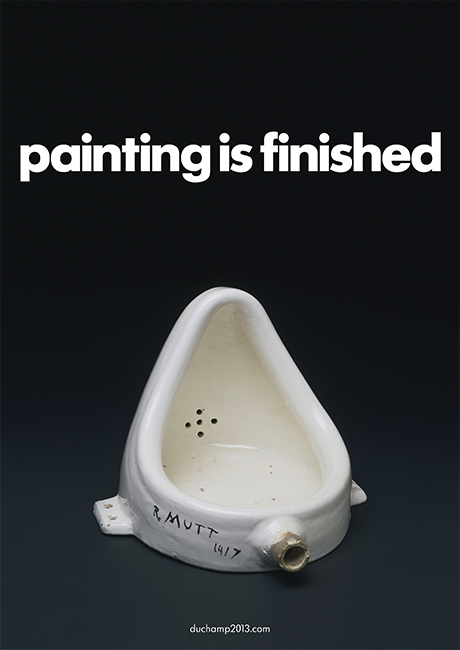Marcel Duchamp – The Bride and the Bachelors
‘All in all, the creative act is not performed by the artist alone; the spectator brings the work into contact with the external world by deciphering and interpreting its inner qualifications and thus adds his contribution to the creative act.’ – Marcel Duchamp

It’s this spirit of placing the spectator firmly in the centre that informs the brilliant new show at London’s Barbican Centre – The Bride and the Bachelors.

Source: © Succession Marcel Duchamp, 2013, ADAGP/Paris, DACS/London
Marcel DuchampNude Descending a Staircase (No. 2),1912
The exhibition examines the works and influence of Duchamp on artists John Cage Robert Rauschenberg and Jasper Johns, and choreographer Marce Cunningham.

Source: Photograph by Hans Wild Courtesy of the John Cage Trust
John Cage and Merce Cunningham John Cage and Merce Cunningham, 1964
The campaign leading up to the exhibition was designed by consultancy Disarm, who also designed its printed materials, and takes the form of a series of images of work form the show, captioned with wry and witty quotes from the featured artists.

Chris Condron and Duncan Bone, Disarm partners, say, ‘The challenge was to create an original approach that engaged a totally new audience, without alienating existing enthusiasts and still showcasing the iconic artworks of Duchamp and those he influenced.’
The exhibition design is a work of art in itself; curated by contemporary artist Philippe Parreno, the space has been devised as a mis en scene, creating an experiential event that surrounds the viewer with the visuals, sound and dance conceived by the five artists.
According to the Barbican, this highly inventive and thoroughly enthralling scene aims to ‘invoke the notion of the ghost, existing between presence and absence’.
Entering the large lower-level space section, The Bride, a self-playing piano stops and starts, and speakers around the room emit a Parreno-curated soundscape of pieces by Cage, Duchamp, David Behrman and Parreno himself.

Source: © John Cage Trust
John Cage Strings 1-20, 1980
As expertly conveyed by the exhibition design, the five artists are united in their emphasis on movement and stillness – whether through brushstrokes, the body, sound or sculpture.
A central platform is filled intermittently with dancers performing a series of Cuningham’s pieces. As they dance, silences in the sound allow the sounds of dancers’ feet, eerily amplified, to create their own rhythms from the sweeping of their feet across the floor, softly padding or loudly thumping as they raise their hands in a strangely haunting proto-vogueing action.

Source: © Jasper Johns / VAGA, New York / DACS, London 2013
Jasper Johns Field Painting, 1963-64
The exhibition design is superbly clever in its subtle nuances – the panels explaining the music are unlit except for one, flashing like an ailing neon sign; while the pieces hanging at different heights and angles around the viewer act as the perfect reflection of the radicalness of Duchamp and his protégées.
The show is arranged thematically, with sections of the upper gallery devoted to chess, chance and the ‘readymade’ – elaborating on Duchamp’s iconic Bicycle Wheel, the first example of his works that used a mass produced object presented as a work of art.

Source: © Jasper Johns / VAGA, New York / DACS, London 2013
Jasper JohnsDancers on a Plane, 1979
While Duchamp, as the Barbican puts it, ‘emphasised ideas over objects, chance over taste and the notion of the artist as provocateur over illustrious creator’, the arrangement of the works by the younger artists show just how his ideas – whether realised as a physical thing of beauty (or not) or as scrawled concepts – played a hugely important role in shaping the art of the 20th century.

Source: © The Robert Rauschenberg Foundation. DACS, London/VAGA, New York 2013
Robert RauschenbergBride’s Folly, 1959
Cage, for instance, frequently modified pianos; Johns’ work uses recognisable iconography such as flags and numbers, and Rauschenberg’s assemblages are formed from materials he found in the street.
So while undoubtedly Duchamp’s most famous work is his 1917 Fountain, this exhibition celebrating his enormous legacy proves there’s a hell of a lot more to him than that little porcelain urinal.

Source: © Succession Marcel Duchamp, 2013, ADAGP/Paris, DACS/London
Marcel Duchamp Fountain, 1950 (replica of 1917 original)
The Bride and the Bachelors Duchamp with Cage, Cunningham, Rauschenberg and Johns runs for 14 February – 9 June at The Barbican Art Gallery, Silk Street, London EC2Y
-
Post a comment




